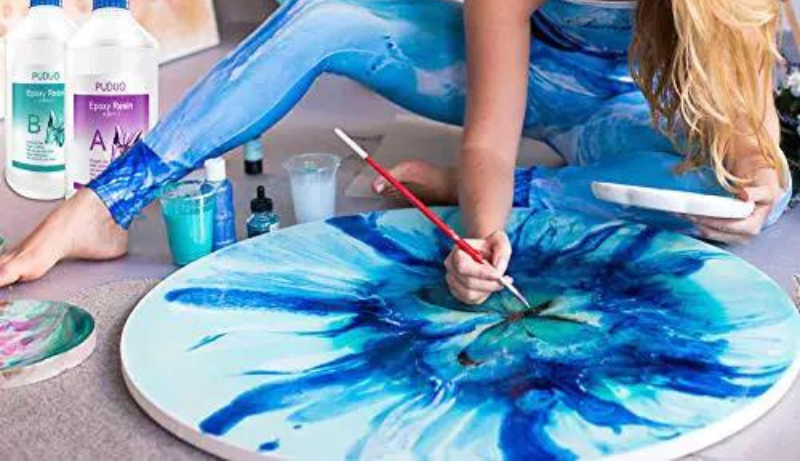Starting a project involving epoxy resin requires a good understanding of which materials it won’t adhere to. While epoxy bonds to many surfaces, there are specific materials that won’t form a bond with epoxy resin. These non-stick surfaces are ideal for various epoxy-related applications, such as molds. Each material has its own set of advantages and disadvantages that impact the epoxy-setting process.
This list provides a solid starting point for selecting non-stick surfaces for your epoxy projects. It’s important to consider the pros and cons of each material and how they affect the epoxy curing process.
Does Resin Stick to Plastic?
Sheathing Tape:
Sheathing tape offers flexibility in size and affordability, making it suitable for various applications. It can be reused when applied correctly and enables the creation of different shapes and angles with a glossy finish. However, it may leave seams that require buffing and sanding. The flatness of the tape depends on the surface it’s applied to, and larger molds may take more time to construct.
Most Plastic Containers:
Common plastic containers like bowls, Tupperware, and cups are inexpensive and readily available for use as molds. They work well for standard shapes, such as bowls or paperweights, but aren’t customizable for larger pieces like tables.
Hot Glue:
Hot glue is useful for sealing cracks and creating molds on river tables to prevent epoxy overflow. It is effective but can be challenging to remove from rough wood surfaces and may leave marks. It is typically used in combination with other materials.
Vinyl, Silicone, and Rubber:
These materials are popular for making smaller epoxy items like jewelry and coasters due to their flexibility in creating various shapes. They are affordable, heat-resistant, and require minimal post-processing. However, they may not be suitable for large projects like furniture, and it’s essential to select polished molds designed for epoxy resin use.
Polyethylene Plastics:
Polyethylene plastic is a premium option known for its strength and reusability. It’s favored by professionals, especially those working on epoxy river tables. It can be ordered to specific size and strength requirements but tends to be more expensive and requires some experience to choose the right density and size.

Plastic Sandwich Bags:
In a pinch, standard gallon-sized plastic sandwich bags can be used for small epoxy projects, but they are not the ideal choice.
Parchment and Wax Paper:
Parchment and wax paper are cost-effective options for creating molds or providing a surface under live-edge epoxy pours. However, they may lead to slightly less clarity in the epoxy due to wax transfer and may shift during curing, potentially causing issues.
Choosing the right non-stick surface for your epoxy project depends on your specific needs, budget, and the size of your project. Each material has its unique characteristics that can either benefit or pose challenges during the epoxy resin setting process.
Table Tops and Work Surfaces
When embarking on epoxy resin projects, it’s advisable to safeguard your tabletop or work surface with a robust plastic sheeting. This cost-effective sheeting boasts tear resistance due to its substantial thickness. You can effortlessly secure it to your workbench with tape, and the beauty lies in its ability to allow cured epoxy to peel off effortlessly. For a more budget-friendly alternative, consider cutting open a garbage bag or a plastic storage bag. Nevertheless, do bear in mind that prolonged contact with a container of mixed epoxy can cause the plastic sheeting to melt if it overheats.
Another excellent choice is a melamine board, readily accessible from stores like Costco, Lowes, or Home Depot. By applying two to three coats of high-quality automotive paste wax containing carnauba, you can establish a dependable non-stick surface. This hard surface is ideal for precise tasks or clamping, eliminating any interference that plastic might introduce. It’s an excellent option if you need to mark guidelines without dealing with unwanted shifting.
What Epoxy Resin Does Not Adhere To
As evident, it’s essential to evaluate each material on an individual basis, as various applications require distinct techniques. While the list provided serves as an excellent starting point, we recommend exploring additional resources, including articles focused on crafting specific pieces or dedicated mold types. This broader research avenue offers valuable access to free tutorials and comprehensive step-by-step guides for your epoxy resin projects.

Frequently Asked Questions
FAQ 1: What does epoxy not stick to?
Answer: Epoxy does not adhere well to certain surfaces or materials. Here are some examples of what epoxy typically does not stick to:
- Non-Porous Surfaces: Epoxy struggles to bond with non-porous materials like glass, metal, and plastic. These surfaces are often too smooth for epoxy to form a strong bond.
FAQ 2: Does epoxy stick to silicone?
Answer: Epoxy generally does not adhere to silicone. Silicone is a low-surface-energy material, which makes it challenging for epoxy to bond effectively. Prior surface preparation may be necessary to improve adhesion.
FAQ 3: Can I apply epoxy over wax or oil-based finishes?
Answer: Epoxy does not adhere well to surfaces treated with wax or oil-based finishes. These substances create a barrier that prevents epoxy from bonding effectively. To use epoxy on such surfaces, you’ll need to remove or sand off the finish and ensure the surface is clean and dry.
FAQ 4: Will epoxy stick to a wet or damp surface?
Answer: Epoxy should not be applied to wet or damp surfaces. Moisture can interfere with the curing process and weaken the bond. Ensure that the surface is completely dry before applying epoxy for the best results.
FAQ 5: Does epoxy bond to all types of wood?
Answer: While epoxy generally adheres well to wood, it may not bond effectively to certain oily or resinous woods such as teak or cedar. These woods can hinder epoxy’s ability to form a strong bond. To improve adhesion, you can sand the wood and use epoxy primers specifically designed for difficult-to-bond woods.

